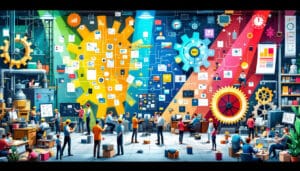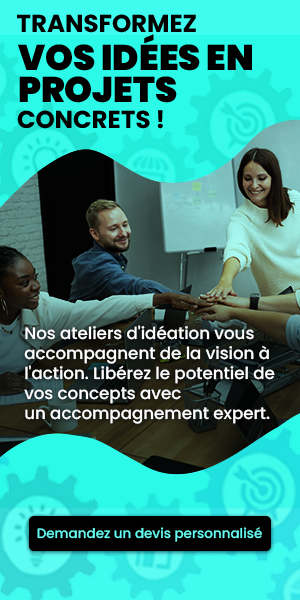In a world where technology evolves at a breakneck speed, it becomes crucial not to lose sight of what really matters: people. Recent innovations offer unprecedented opportunities to improve our lives through smart and immersive tools. However, this acceleration also raises ethical and security challenges that we must address with creativity and responsibility.
🔥 Nous recommandons Ideamap
Ideamap est l’outil idéal pour un brainstorming ou un projet collaboratif. Grâce son interface facile et à ses fonctions IA, Ideamap booste votre créativité tout en favorisant une meilleure organisation de vos idées pour atteindre vos objectifs.
In a recent episode of the Creative Confidence Podcast, Mina Seetharaman from IDEO U spoke with Grace Hwang, former General Manager of UX Design and Research for Mixed Reality at Microsoft. Their conversation highlighted the importance of human-centered design in navigating this rapidly changing technological landscape. Grace, a passionate advocate for ethical design, shared enriching perspectives drawn from her experiences at Microsoft, in health startups, and at IDEO.
Grace emphasized that technology must serve a human purpose. “Technology is a means to an end, not an end in itself,” she stated. She illustrated this point with the development of HoloLens, where continuous engagement with end users revealed real values, such as hands-free interaction in high-stakes environments.
The speed of innovation carries risks. Grace mentioned tools like Midjourney and large language models which, while accelerating the ideation process, increase the danger of heading in the wrong direction. She stressed the importance of implementing feedback loops and integrated learning cycles that allow for testing hypotheses and synthesizing feedback to guide prototypes in an informed manner.
With the advent of immersive technologies in classrooms, workplaces, and therapies, safety must be integrated from the very beginning of the design process. Grace presented a layered framework developed with her team at Microsoft, encompassing proactive security, reactive security, and clear communication about data collection and usage.
Grace also insists on the importance of designing for the margins, meaning for often overlooked users, such as people with disabilities. She shared examples from Microsoft’s Inclusive Tech Lab, where the early inclusion of affected individuals helped reduce bias and create more robust and accessible products.
In conclusion, Grace Hwang reminds us that understanding human behavior and the deep motivations of users is a major competitive advantage. Whether it’s to integrate AI into an organization or to develop the next generations of immersive tools, staying human-centered is essential to building with integrity, agility, and heart.

In the age of artificial intelligence (AI) and new technologies, preserving a human-centered approach has become a major challenge. As technological innovations rapidly transform our daily lives, it is crucial to ensure that these advancements primarily serve human needs and values. This article explores strategies and best practices to keep humanity at the heart of the design and use of emerging technologies.
What are the main challenges for a human-centered approach in the age of AI?
The integration of AI and advanced technologies poses several challenges for a human-centered approach. First, there is a tension between technological efficiency and the preservation of human values such as empathy, ethics, and privacy. Automation can sometimes lead to a dehumanization of interactions, where decisions are made by algorithms without consideration of personal and social contexts.
Next, the speed of innovation presents the issue of regulation. Legislation and ethical frameworks often struggle to keep pace with technological advancements, which can lead to abusive uses of AI, such as intrusive surveillance or algorithmic bias.
Furthermore, accessibility to technologies plays a crucial role. It is essential to ensure that innovations do not create new social inequalities but are inclusive and beneficial for all segments of society. Lastly, the issue of transparency and explainability of AI systems is fundamental to establishing trust between users and the technologies they use.
How can artificial intelligence support human-centered design?
Artificial intelligence can be a powerful ally in reinforcing a human-centered approach. Indeed, AI allows for the collection and analysis of vast amounts of data on user behaviors and needs, thus providing valuable insights for the design of more suitable products and services.
For example, machine learning algorithms can identify trends and preferences that would be difficult to detect manually. This enables designers to create personalized user experiences that better meet individuals’ expectations. Additionally, AI can automate certain repetitive tasks, freeing up time for design teams to focus on more creative and empathetic aspects of design.
Moreover, AI tools can facilitate rapid prototyping and user testing methods, allowing for faster iteration and continuous improvement of products. For instance, AI-based simulations can predict how users will interact with a new product even before it is produced, thus reducing the risk of market failure.
However, for AI to truly support a human-centered approach, it is essential to use it in an ethical and responsible manner. This includes ensuring algorithmic transparency, protecting personal data, and eliminating biases to avoid unintentional discrimination.
What practices to adopt to keep humans at the heart of emerging technologies?
To ensure that emerging technologies remain human-centered, several practices can be adopted:
1. Participatory design: Involving end users from the early stages of design allows for direct feedback collection and ensures that the product truly meets their needs. This approach fosters better understanding of users’ expectations and frustrations.
2. Integrated ethics: Incorporating ethical principles from the design phase and throughout the product lifecycle is crucial. This includes establishing ethics committees, conducting regular audits, and training teams on ethical best practices.
3. Universal accessibility: Designing technology accessible to everyone, including people with disabilities, ensures that innovations benefit a larger part of the population. Using recognized accessibility standards and testing products with diverse user groups are essential steps.
4. Transparency and explainability: Making AI systems transparent and explainable allows users to understand how decisions are made. This builds trust and enables users to feel in control of the technology.
5. Continuous training: Training development and design teams on the issues of AI and human-centered technologies is essential. This includes training on new technologies, empathetic design methods, and ethical considerations.
The impact of technologies on privacy and personal life
With the rise of AI and data collection technologies, users’ privacy and personal life are more threatened than ever. Technologies such as biometric sensors, wearables, and smart applications continuously collect personal data, raising questions about the security and use of this information.
To maintain a human-centered approach, it is essential to implement robust data protection measures. This includes encrypting sensitive information, minimizing data collection to what is strictly necessary, and implementing transparent privacy policies.
Informed consent: Users must be fully informed about how their data is collected, used, and shared. Consent must be explicit, and users should have the option to withdraw their consent at any time.
Data governance: Implementing strict data governance ensures oversight of the use of collected information and ensures that practices comply with ethical and legal standards. Regular audits and internal control mechanisms are necessary to ensure compliance and data security.
Transparency: Companies must be transparent about their data collection and usage practices. Publishing transparency reports and communicating clearly and honestly with users are key steps to building trust.
Case studies: inspiring examples of human-centered design
Several companies and projects perfectly illustrate how a human-centered approach can be successfully integrated in the age of AI and new technologies.
Microsoft has implemented initiatives for responsible innovation, focusing on AI ethics and developing tools that integrate inclusive design principles. For instance, their AI lab ensures that algorithms are transparent and fair by involving ethics experts and representatives from diverse communities.
IDEO, a design and innovation company, uses design thinking methods to create solutions that meet real user needs. They offer collaborative workshops where users can actively participate in the design process, ensuring that final products are truly suitable and beneficial.
Another interesting case study is that of Pivot, a digital health startup focused on smoking cessation. Pivot has integrated human coaches with AI tools to provide personalized and effective support. This combination maximizes the effectiveness of interventions while maintaining an essential human presence to enhance user engagement and motivation.
Tools and resources for human-centered design
To adopt and maintain a human-centered approach, several tools and resources can be utilized:
Design Thinking: This method offers a structured framework to understand users, generate creative ideas, and prototype solutions. Resources such as Innovate through design thinking are essential to delve deeper into this approach.
Rapid prototyping tools: Software like Sketch, Figma, or Adobe XD allows for the rapid creation of interactive mockups, facilitating user testing and quick iterations.
User feedback platforms: Tools like UserTesting or Hotjar enable real-time feedback collection, helping to refine products based on the real needs of users.
Training and certification: Taking courses such as Discover Mina Seetharaman can enhance skills in human-centered design and creative leadership.
(no conclusion requested)














